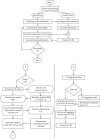Smart Spider Monkey Optimization (SSMO) for Energy-Based Cluster-Head Selection Adapted for Biomedical Engineering Applications
- PMID: 35173558
- PMCID: PMC8818399
- DOI: 10.1155/2022/2538115
Smart Spider Monkey Optimization (SSMO) for Energy-Based Cluster-Head Selection Adapted for Biomedical Engineering Applications
Abstract
Using energy efficiency to increase the life and sustainability of wireless sensor networks (WSNs) for biomedical applications is still a challenge. Clustering has boosted energy productivity by allowing cluster heads to be categorized, but its implementation is still a challenge. Existing cluster head selection criteria start with determining acceptable cluster head locations. The cluster heads are picked from the nodes that are most closely connected with these places. This location-based paradigm incorporates challenges such as faster processing, less precise selection, and redundant node selection. The development of the sampling-based smart spider monkey optimization (SSMO) approach is addressed in this paper. If the sample population's nodes are varied, network nodes are picked from among them. The problems with distributed nodes and cluster heads are no longer a concern. This article shows how to use an SSMO and smart CH selection to increase the lifetime and stability of WSNs. The goal of this study is to look at how cluster heads are chosen using standard SMO and sampling-based SMO for biomed applications. Low-energy adaptive clustering hierarchy centralized (LEACH-C), particle swarm optimization clustering protocol (PSO-C), and SSMO improved routing protocol measurements are compared to those obtained in homogeneous and heterogeneous settings using equivalent methodologies. In these implementations, SSMO boosts network longevity and stability periods by an estimated 12.22%, 6.92%, 32.652%, and 1.22%.
Copyright © 2022 P. Ajay et al.
Conflict of interest statement
The authors declare that they have no conflicts of interest.
Figures




References
-
- So-In C., Permpol S., Rujirakul K. Soft computing-based localizations in wireless sensor networks. Pervasive and Mobile Computing . 2016;29:17–37. doi: 10.1016/j.pmcj.2015.06.010. - DOI
-
- Rath M., Pati B., Pattanayak B. K. Soft Computing in Wireless Sensor Networks . Boca Raton, FL, USA: Chapman and Hall/CRC; 2018. Relevance of soft computing techniques in the significant management of wireless sensor networks; pp. 75–94. - DOI
-
- Dhasian H. R., Balasubramanian P. Survey of data aggregation techniques using soft computing in wireless sensor networks. IET Information Security . 2013;7(4):336–342. doi: 10.1049/iet-ifs.2012.0292. - DOI
-
- Das S. K., Kumar A., Das B., Burnwal A. P. Ethics of reducing power consumption in wireless sensor networks using soft computing techniques. International Journal of Advanced Computer Research . 2013;3(1):p. 301.
MeSH terms
LinkOut - more resources
Full Text Sources
Miscellaneous
